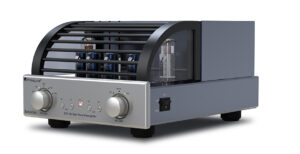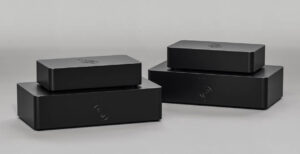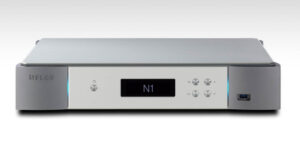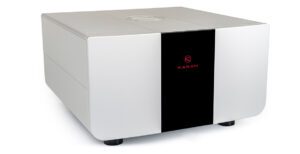
Node Audio is a brand-new operation that’s both radical and unusual. Situated a few miles south of Cambridge, Node shares an advanced manufacturing facility with a hi-tech engineering company. Its two key principals are Ashley May and David Evans: essentially hi‑fi enthusiasts who have operated successfully as industrial design consultants for nearly a decade. However, the company has also brought in the established and experienced acoustic engineer Christien Ellis to help with the design technicalities, a name that will be familiar to anybody who recalls Mission in its pomp.
Together, the three have created a new and decidedly unusual loudspeaker called the Hylixa, which combines wide bandwidth with compact dimensions. (The name is initially a play on the word Helix, referring to the ‘Helical Transmission Line that lies at the core of this design’s good bass extension.)
The egg-shaped styling is striking (albeit somewhat reminiscent of the Japanese Eclipse brand), with a shiny reflective boss housing the drivers on the front, giving the speaker something of a ‘War of the Worlds’ appearance. The rest of our sample’s enclosure came finished in high gloss black, though any colour may be specified, in either gloss or ‘soft-touch silk’ finish. Ultimately, the Hylixa is arguably one of the very few audio products that might appeal to those who also have to live with the results. In less ‘woke’ times, this was known as WAF, or ‘wife acceptance factor’.

The enclosure’s helical transmission line is created by a process known as ‘Selective Laser Sintering’, a version of 3D printing in which tiny (0.2mm) particles of glass and nylon are alternately fused by a laser under computer control. The result is an enclosure which has virtually zero cabinet coloration, and because of the shape also has virtually perfect acoustic distribution.
The down side, however, is a very high price tag that starts at £27,000 per pair, which means that it’s possibly the costliest speaker to come my way in forty odd years. There are plenty that are larger, heavier, and more expensive still, but this is certainly a genuine high-end speaker nonetheless, albeit rather different from most in philosophy and manufacture.
I regularly use two power amplifiers. The Naim Audio NAP 500 DR is rated at 140W/channel, whereas my Howes single-ended PX4 triode monoblocks have just 3.5W output. For reasons of long-term reliability I tend to use the Naim most of the time, but I am very conscious that the valve amps not only sound rather sweeter, but also go loud enough for most purposes.
How much power do we really need? Not very much, it would seem. Furthermore, sensitivity tends to be inversely proportional to bulk, so why not sacrifice some sensitivity in order to minimise bulk? Instead of having a considerable excess of power available to drive a pair of average sensitivity loudspeakers, let’s reduce both the sensitivity and the bulk of the speakers (this could be called the LS3/5a syndrome!).
The BBC LS3/5a might be the classic example of accepting low sensitivity in order to minimise bulk, but much the same could be said of this Node Hylixa. While it does resemble the Eclipse speakers, the resemblance is purely superficial because this is actually a three-way design (as distinct from an Eclipse’s single full-range drive unit).
Which should not imply that the Hylixa is in any way conventional – quite the reverse, in fact. Operating below 200Hz, the bass driver is hidden within the enclosure, and is loaded by a helical transmission line that actually exits through a ring surrounding said bass driver. Nor is that the only unconventional element, as the midrange drive unit is a BMR (balance mode radiator) device, with a diameter of about 4.5cms, running from a low 200Hz up to a high 5kHz. Only the tweeter is a relatively conventional device, as it’s simply a soft fabric ‘doughnut’, held between a central ‘spike’ and an edge surround.
Furthermore, the Hylixa comes complete with its own integrated stand – arguably essential in view of its egg-like shape – and this adds substantially to the elegance of the whole package. A solitary pillar, shaped and slanting backward from above, drops around 60cms below the ‘egg’ before spreading out into a tripod with an unusually large footprint that measures roughly 37cms wide and deep.
The spiked feet themselves are both very decorative and large in diameter, as is their locking arrangements. A single terminal pair is fitted at the lower part of the hollow stand/pillar, which also accommodates the necessarily complex three-way, second-order crossover network.
This undoubtedly complicated loudspeaker incorporates a great deal of advanced detail design and engineering. The crucial question therefore has to be whether or not the sound quality can measure up to the excellent presentation – or indeed the hefty price.
Measurement confirms a number of observations, starting with the basic fact that the Hylixa does indeed combine low sensitivity (estimated c. 83dB) with fine bass extension. That said, while the far field averaged frequency response above 250Hz is essentially very well judged and impressively even, the bass end seems to be rather less smooth. Although the actual extension is quite impressive, significant excess is seen at around 50Hz, alongside some loss of output between 100–250Hz.
The impedance trace might be a trifle curious, but it does at least stay above 6ohms for most of the audio band. However, it’s a little too current-heavy from 70Hz up to 300Hz, and this seems to be especially true around 100Hz, where it drops briefly below 3ohms.
I found that this speaker became increasingly seductive over the time I spent listening to it, though this should not be taken to endorse its total sound quality. I’ve long suspected that high sensitivity is a good thing for the sake of dynamic drama, and that would seem to be further reinforced here, as dynamic expression is a little too restrained. However, the level of box coloration is very low indeed, so the noise floor is similarly low; dynamics therefore might be somewhat challenged, but the actual dynamic range is consequently very high.

In fact, despite its compact dimensions, this speaker does have serious high-end capabilities, as I discovered when subsequently carrying out some serious listening tests. I was comparing a Rega Aura moving-coil phono stage with an Audio Note S9 transformer feeding a Pure Sound P10 phono stage, and it was clear that the (costlier) S9/P10 combination did have an advantage through the Hylixa loudspeakers (using Naim amplification).
I was even more impressed when using the S9/P10 combo to compare an original pressing of Freewheelin’ by Bob Dylan [Columbia] with a recent reissue of the same disc. Although the two had seemed virtually identical viathe solid-state Aura, the difference was altogether more obvious when using the S9/P10 combo (and favouring the original). Once again, the Hylixa proved quite capable of distinguishing without ambiguity between the two versions, which is further evidence of its genuine high-end capabilities.
It took quite a while for the penny to drop, but the crucial fact about this loudspeaker is that it looks small but sounds large – a paradox that certainly plays with the senses. When one sees a small loudspeaker, one automatically assumes that it will have limited bass extension. In most cases this is undoubtedly the case, but the Hylixa is very much an exception to this rule, as it delivers a bottom end extension that is normally only found in a much larger loudspeaker.
Alongside this remarkable sense of scale is an equally superior stereo imaging performance. First there’s an almost unbelievable ‘out of the box’ sound, as the sound does indeed avoid clinging in any way to the enclosures, and instead creates considerable depth perspectives. Furthermore, my better half discovered that she could hear a central stereo image, even when sitting well off-axis and quite close to one of the pair.
This seems to be all good news, but there is also a down side, as the second-order crossover network adds a degree of time-smear to the overall sound, with a bass that comes in slightly late.
Although the Hylixa is unquestionably a very costly prospect, it’s also rather good, especially in terms of its exceptional stereo imaging, plus arguably the lowest cabinet coloration I have ever encountered. That said, dynamics could be stronger, bass timing is slightly slow, and the frequency response measurements are a bit wayward at low frequencies. However, at higher frequencies the balance seems close to ideal, with no indication of a presence ‘dip’ or unwelcome ‘forwardness’, and an exceptional dynamic range.
Recommendation seems very appropriate here, as there’s no avoiding the fine sound quality in its areas of strength. But it’s also essential to add the proviso that this loudspeaker is very expensive, so it should only be considered by those interested primarily in the impressive compactness and styling, rather than value for money per se.

TECHNICAL SPECIFICATIONS
- Type: 3-way floorstanding helical transmission line loudspeaker
- Enclosure: Laser-fused single-part cabinet, featuring a 1.6m transmission line fed from two optimised points, with no flat surfaces
- Drive Units: 1× 25mm ring radiator supertweeter, 1× 46mm wideband BMR, 1x140mm bass unit
- Frequency Response: 39Hz–25KHz (+-6db)
- Impedance: (6 ohm Nominal /2.6 ohm Minimum):
- Sensitivity: 82.4dB (2.83V/1m)
- Finishes: Cabinet in either high gloss or satin silk in any colour. Baffle fascia and feet finished in anodised black, polished nickel, polished copper, or polished 24 Karat gold. Specialist finishes by request.
- Dimensions (H×W×D): 971 ×433 ×435mm
- Weight: 15kg/each
- Price: From £27,000/pair
Manufacturer: Node Audio Research Ltd
URL: node-audio.com
node–audio.com/where-to-experience/
Tel: +44 (0)1223 895854
Tags: FEATURED
By Paul Messenger
More articles from this authorRead Next From Review
See all
PrimaLuna EVO 100 phono preamplifier
- Apr 22, 2024

Reiki Audio SuperSwitch Master Pro + Servant Pro
- Mar 27, 2024

Melco Audio N1-S38 music server
- Mar 27, 2024











